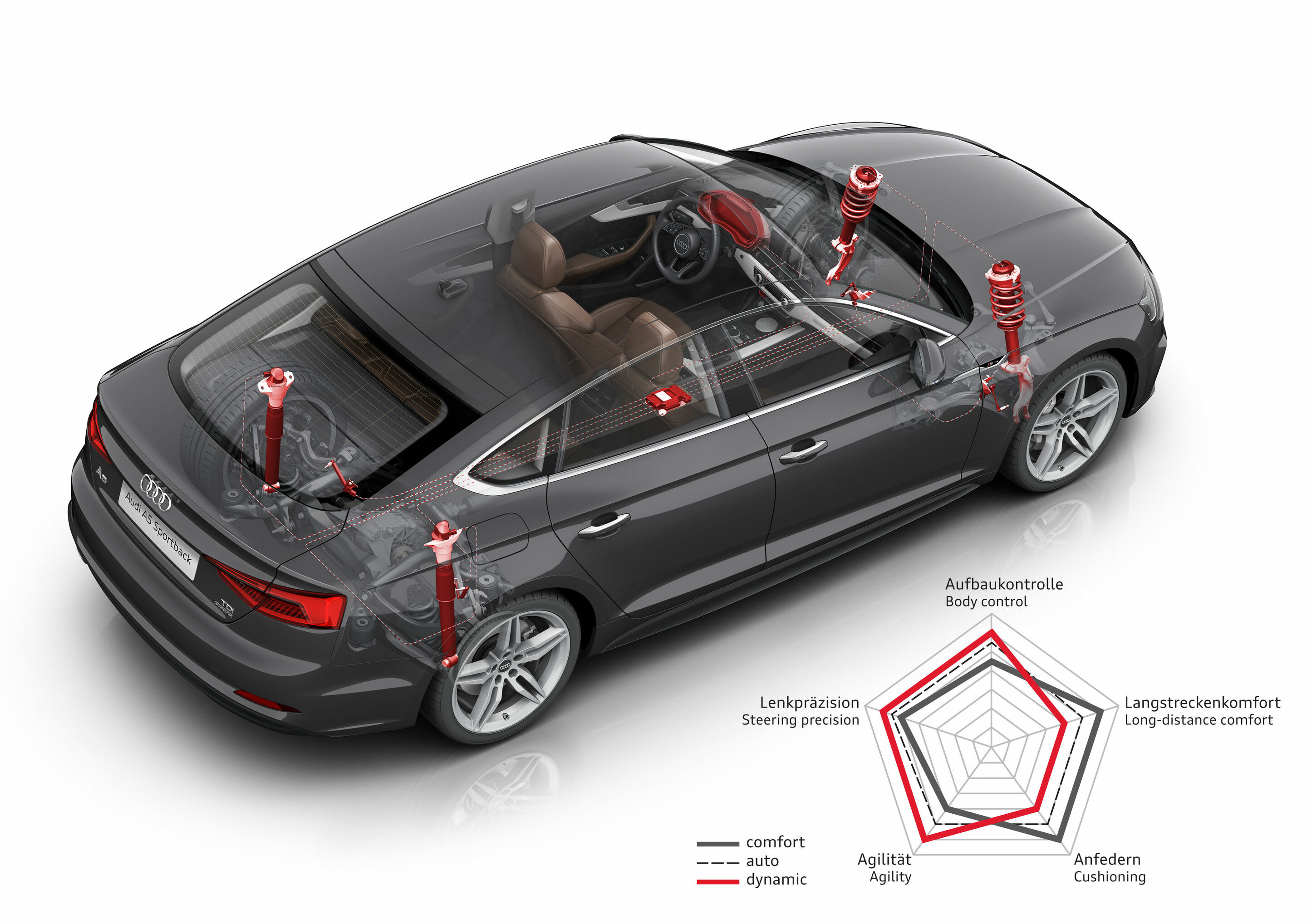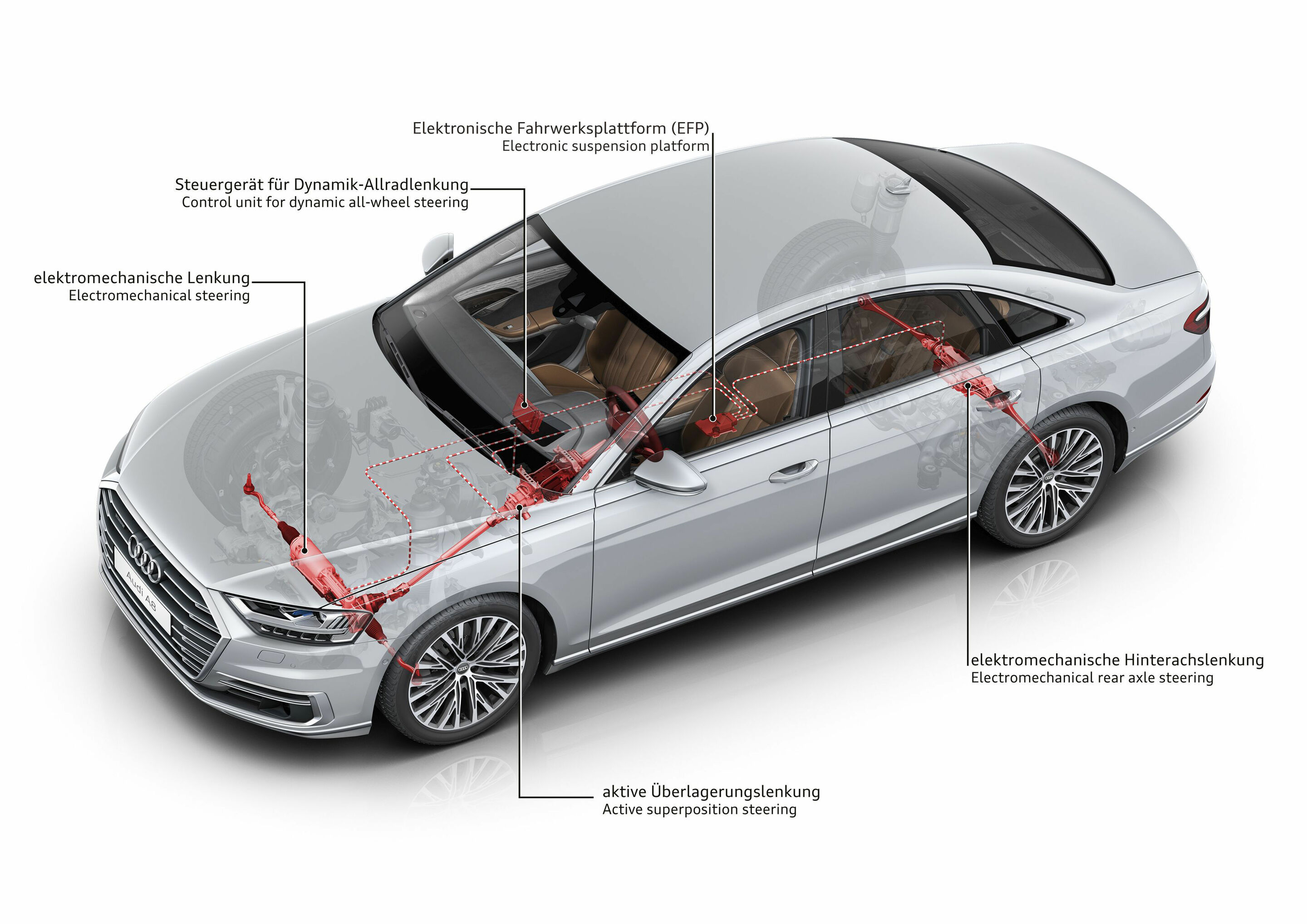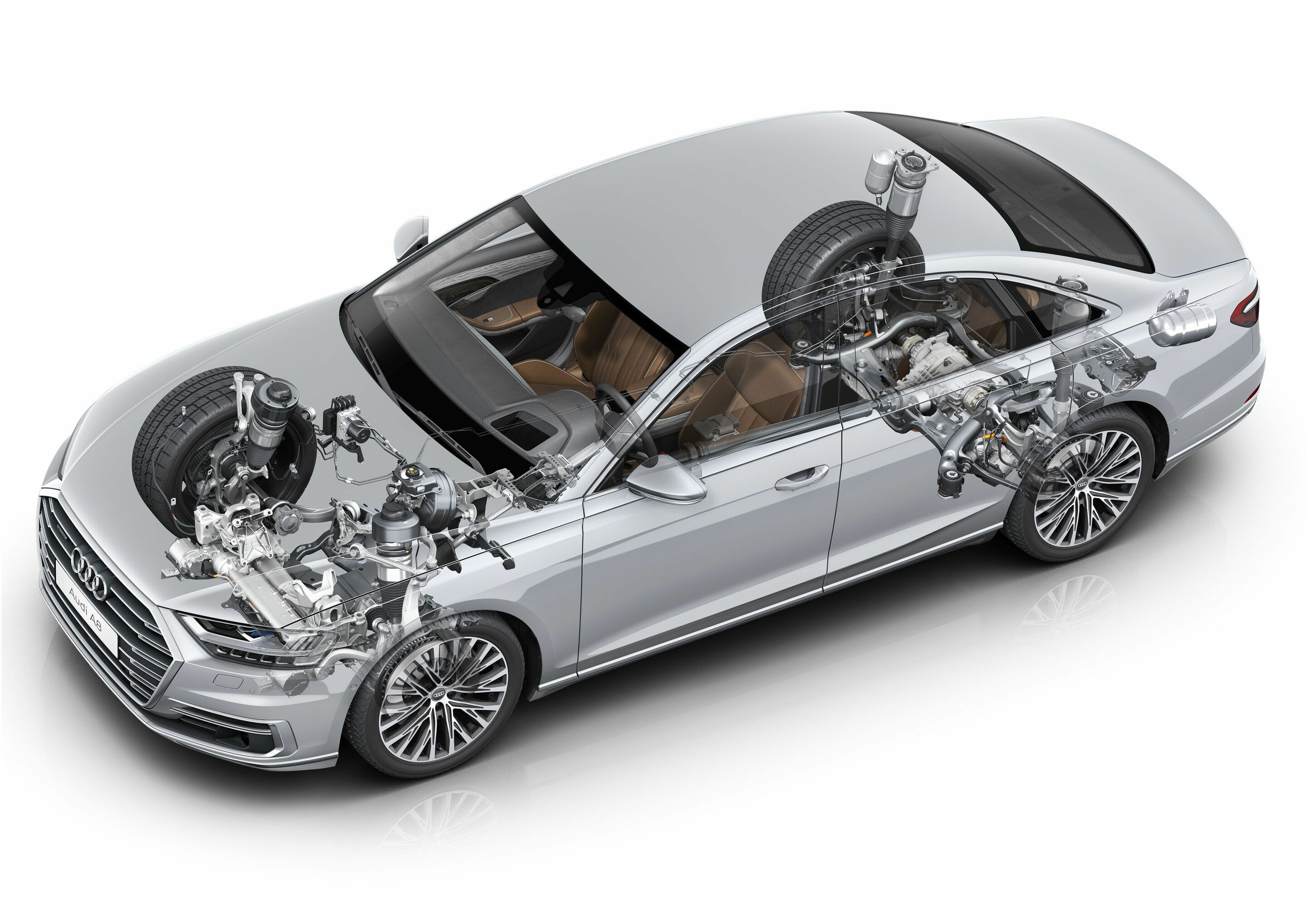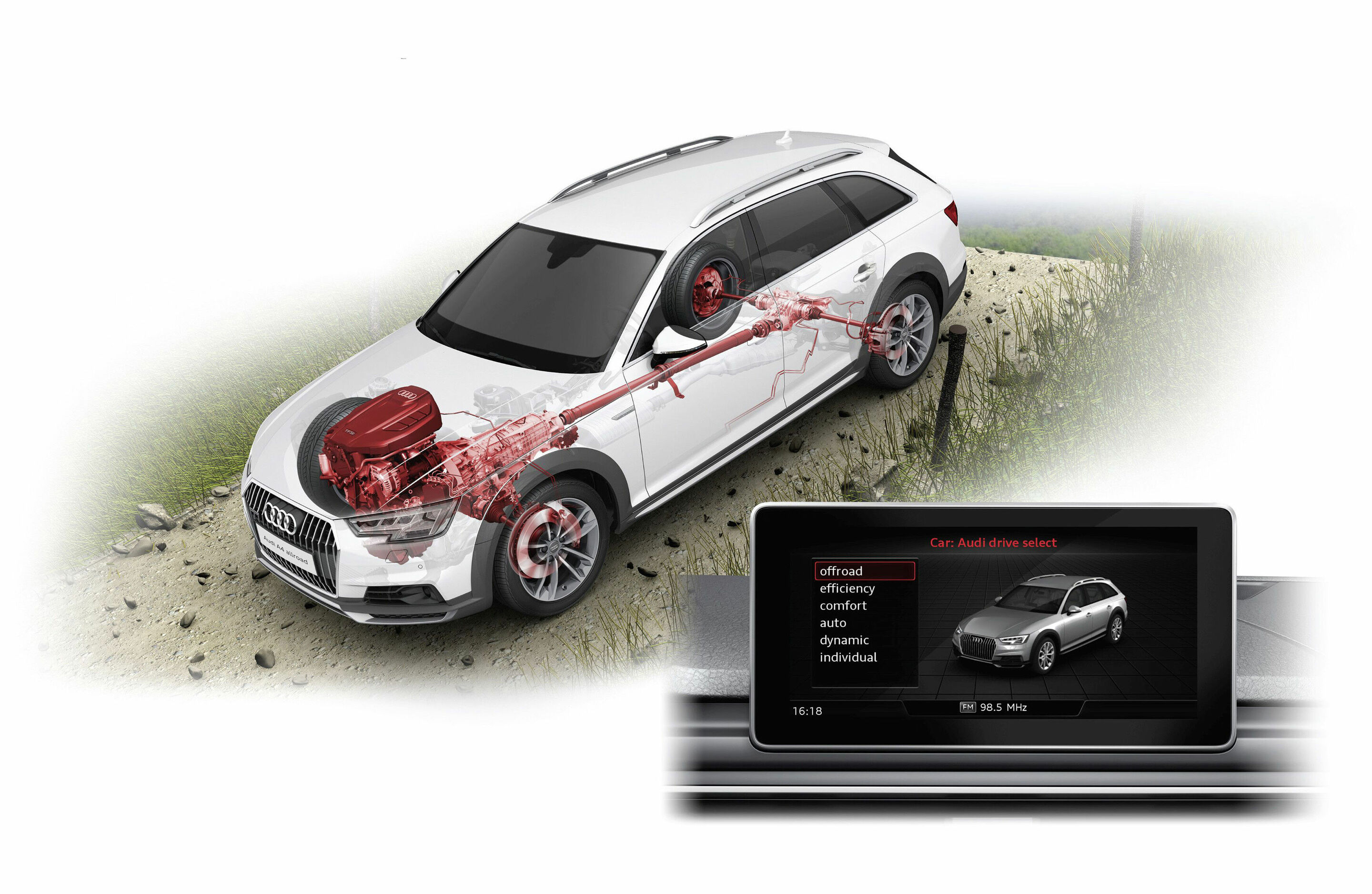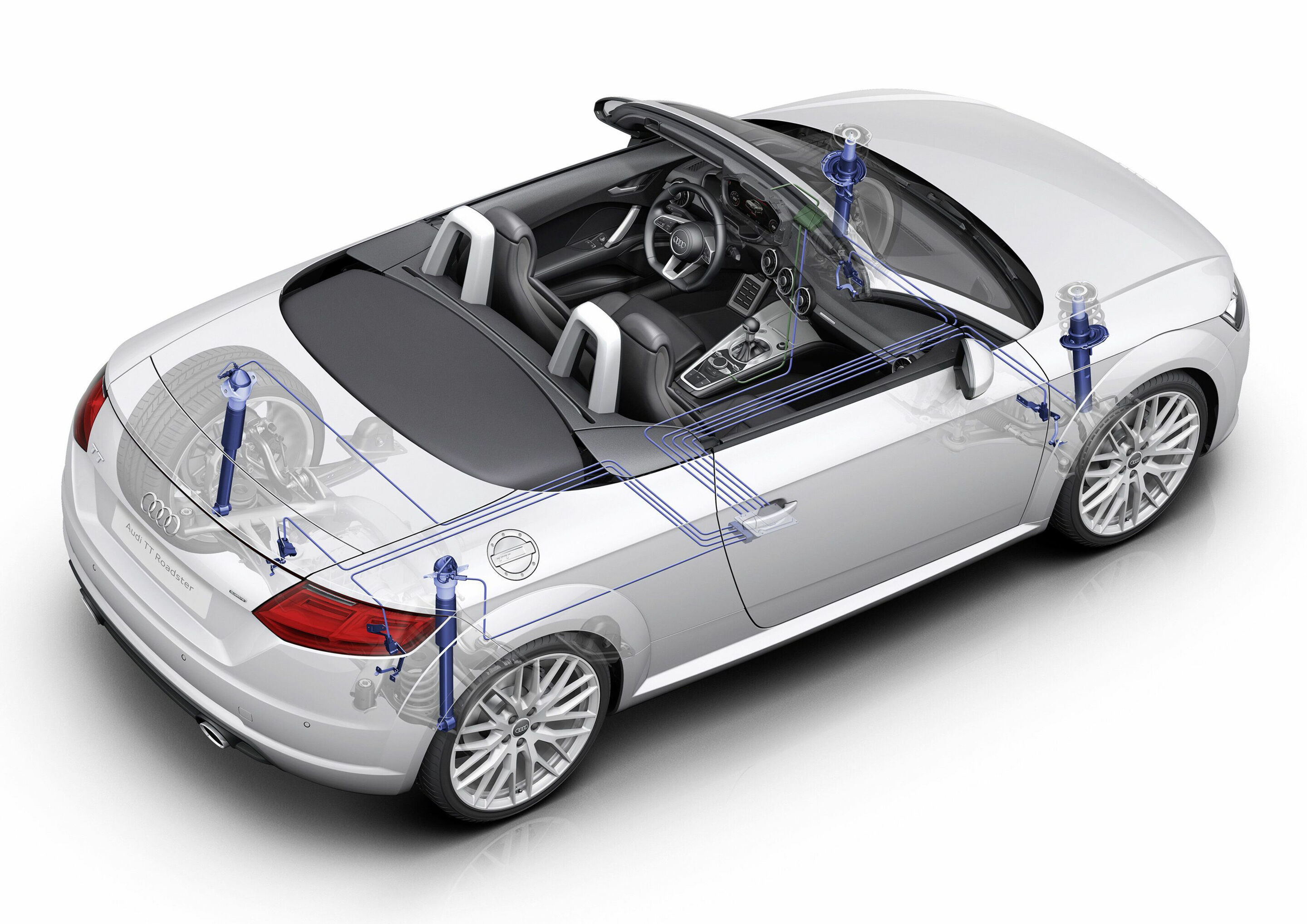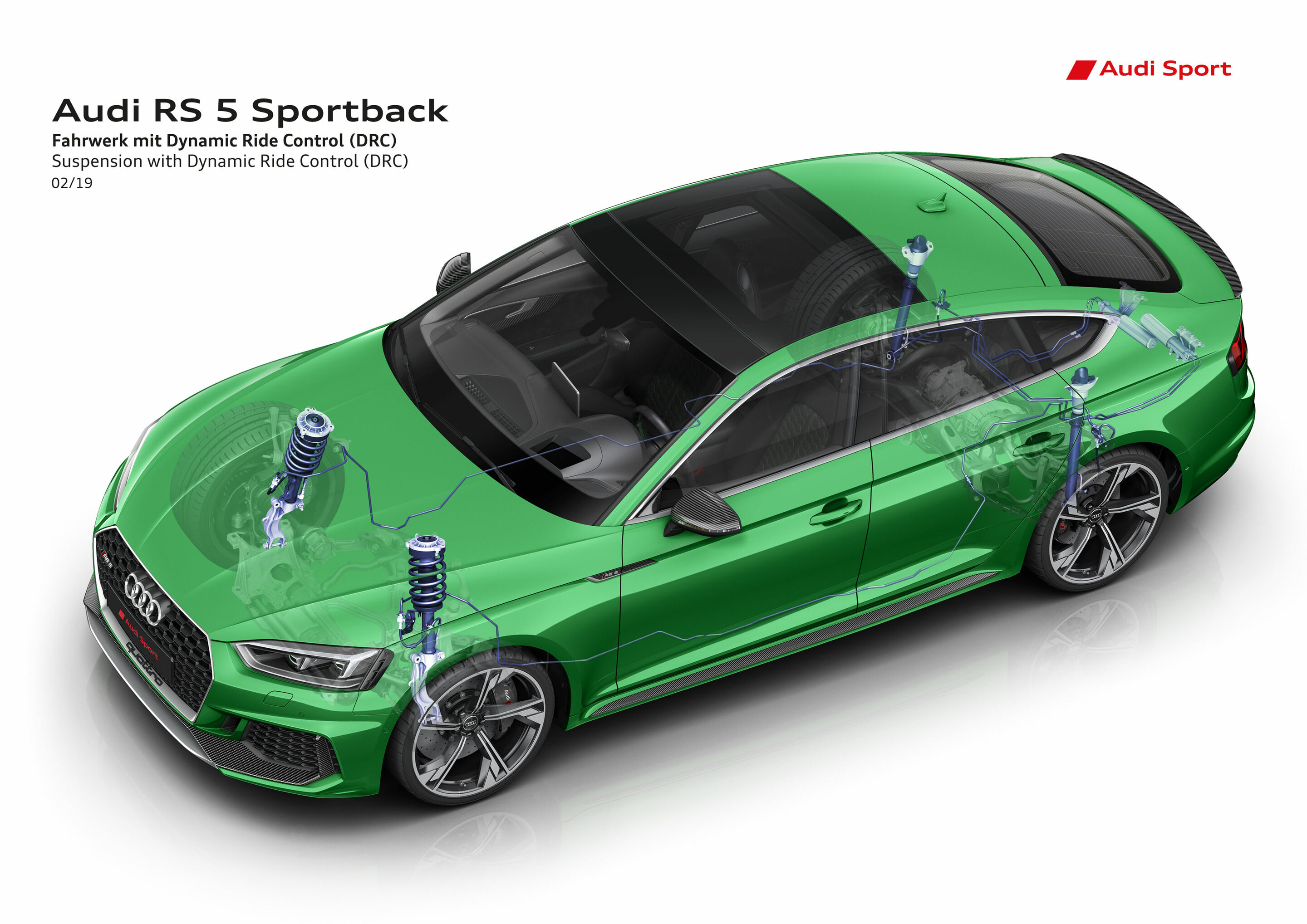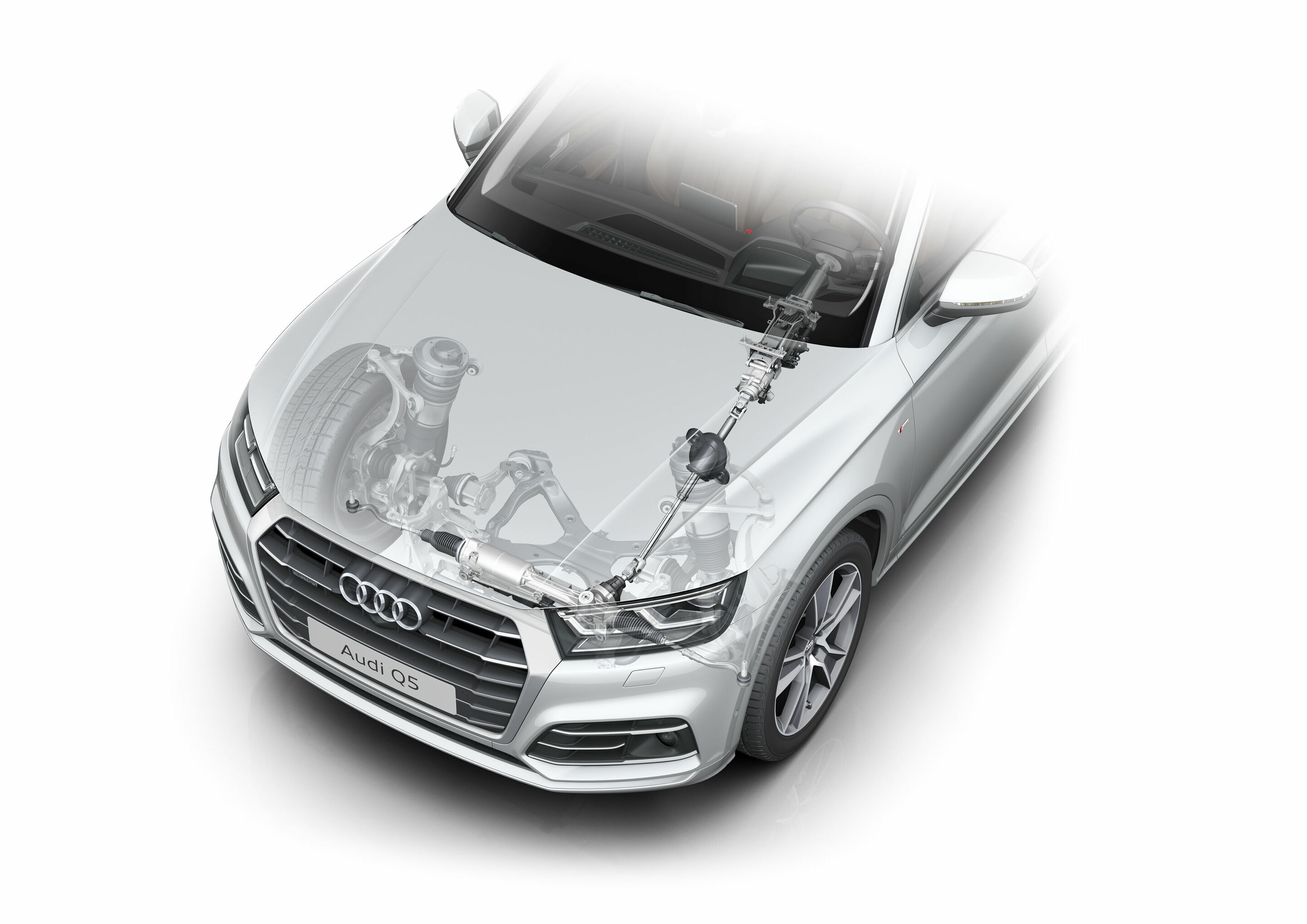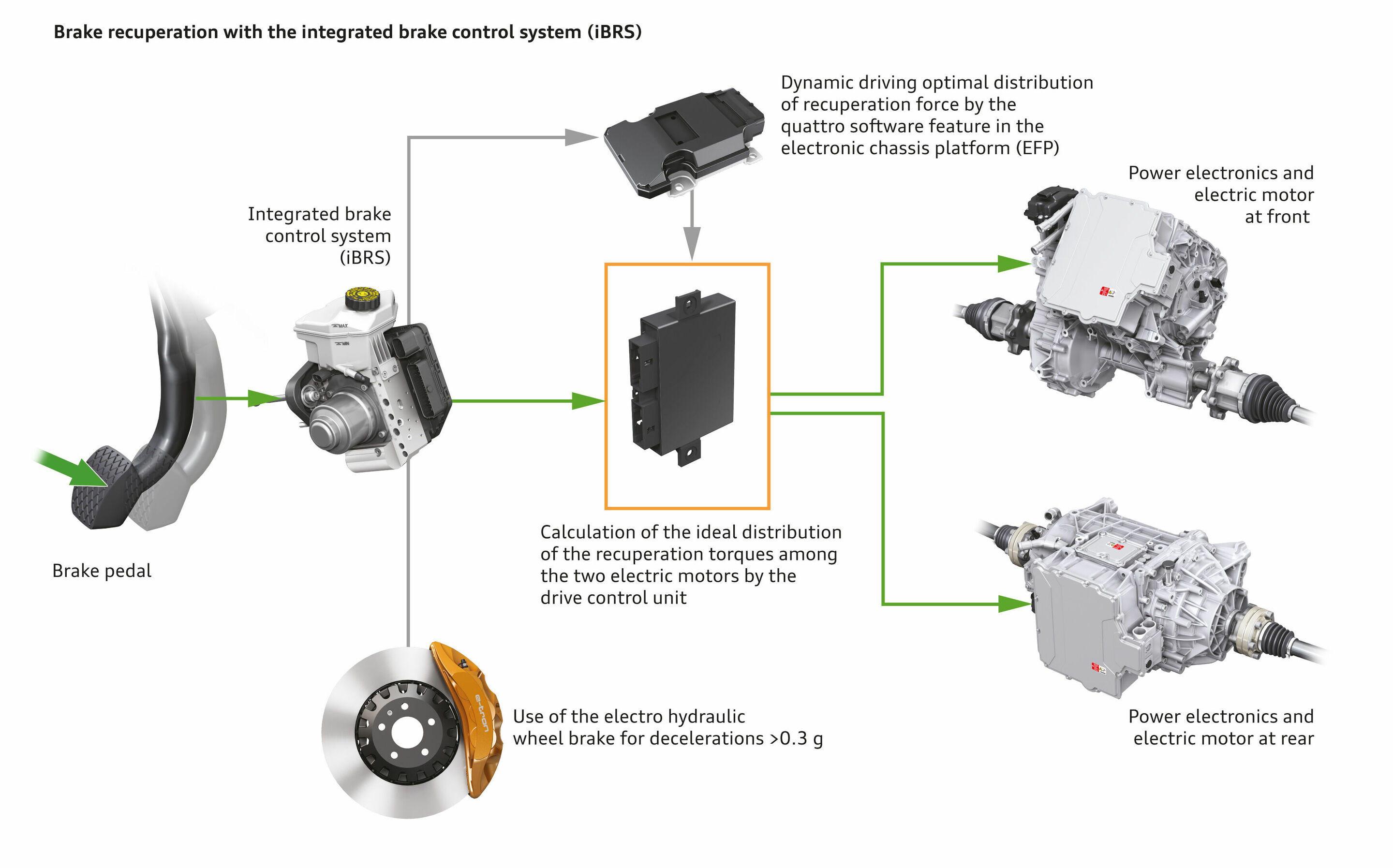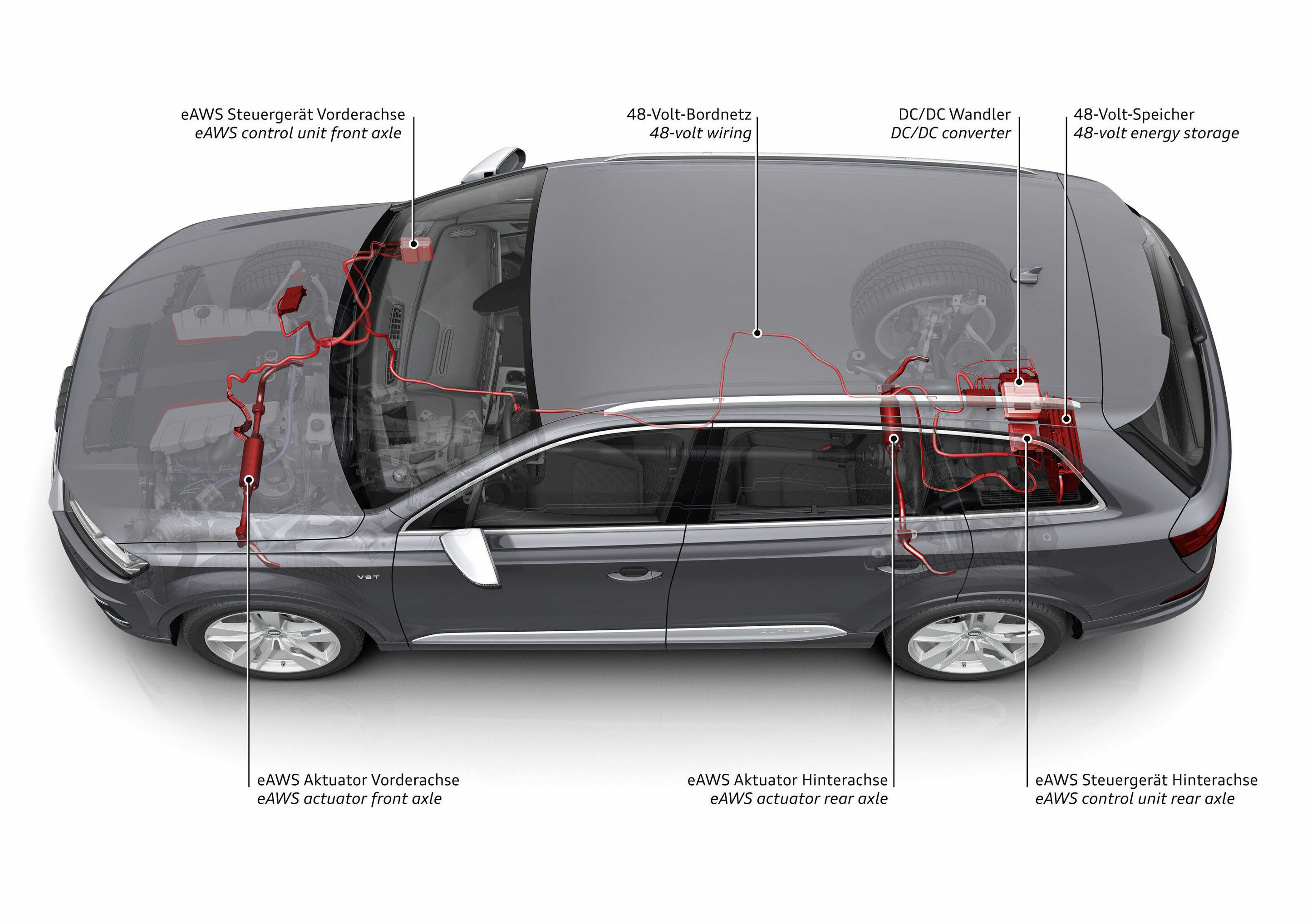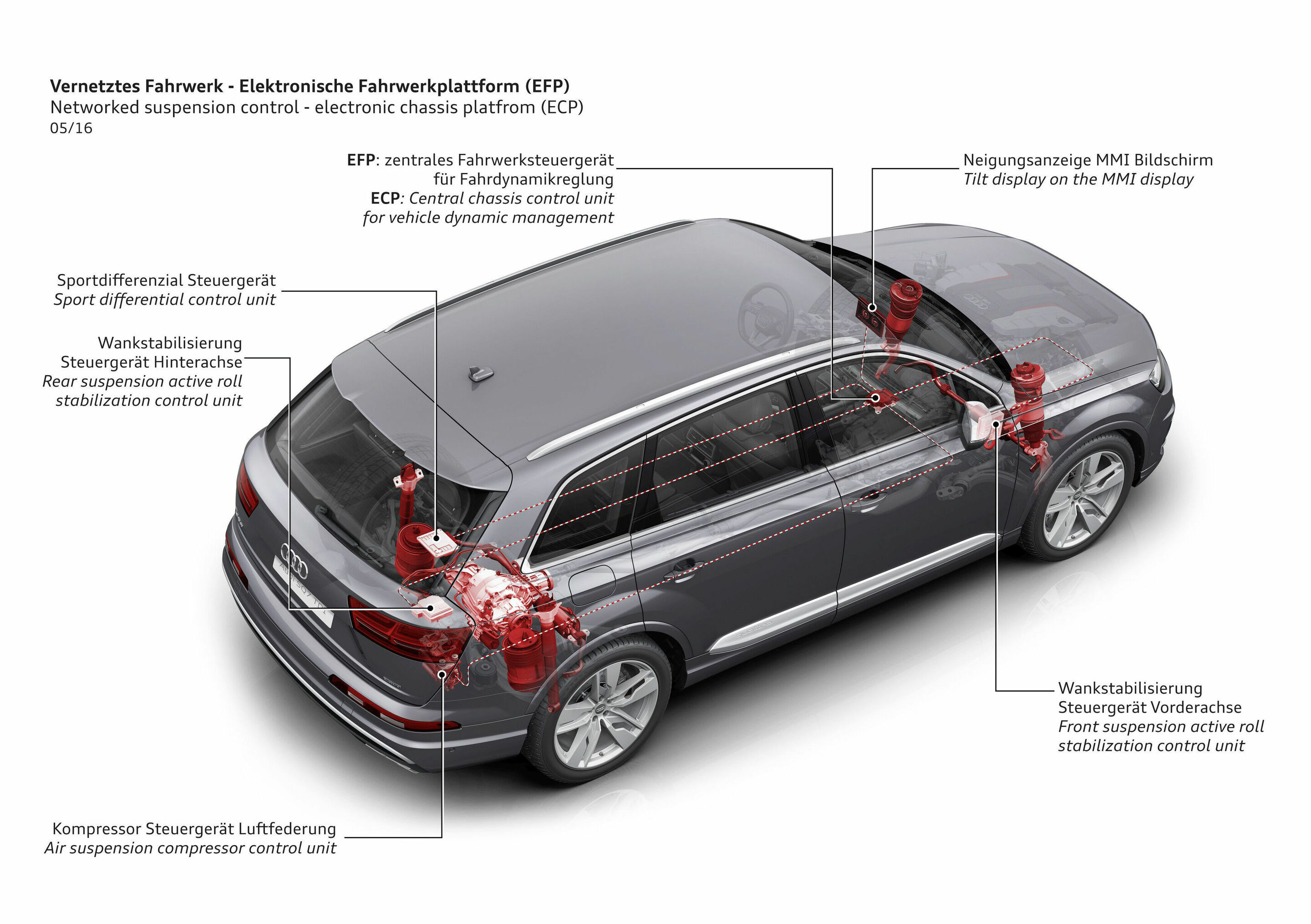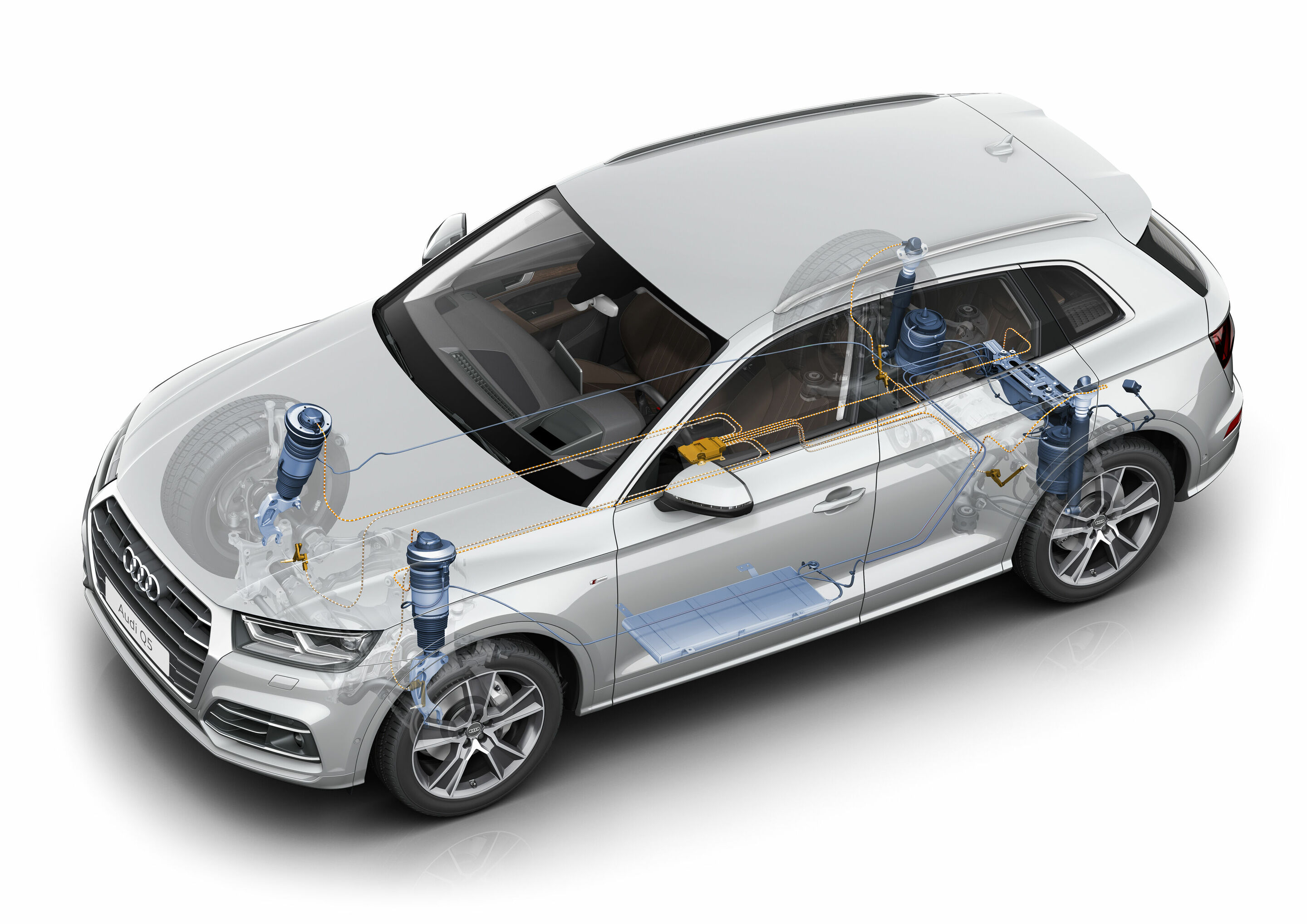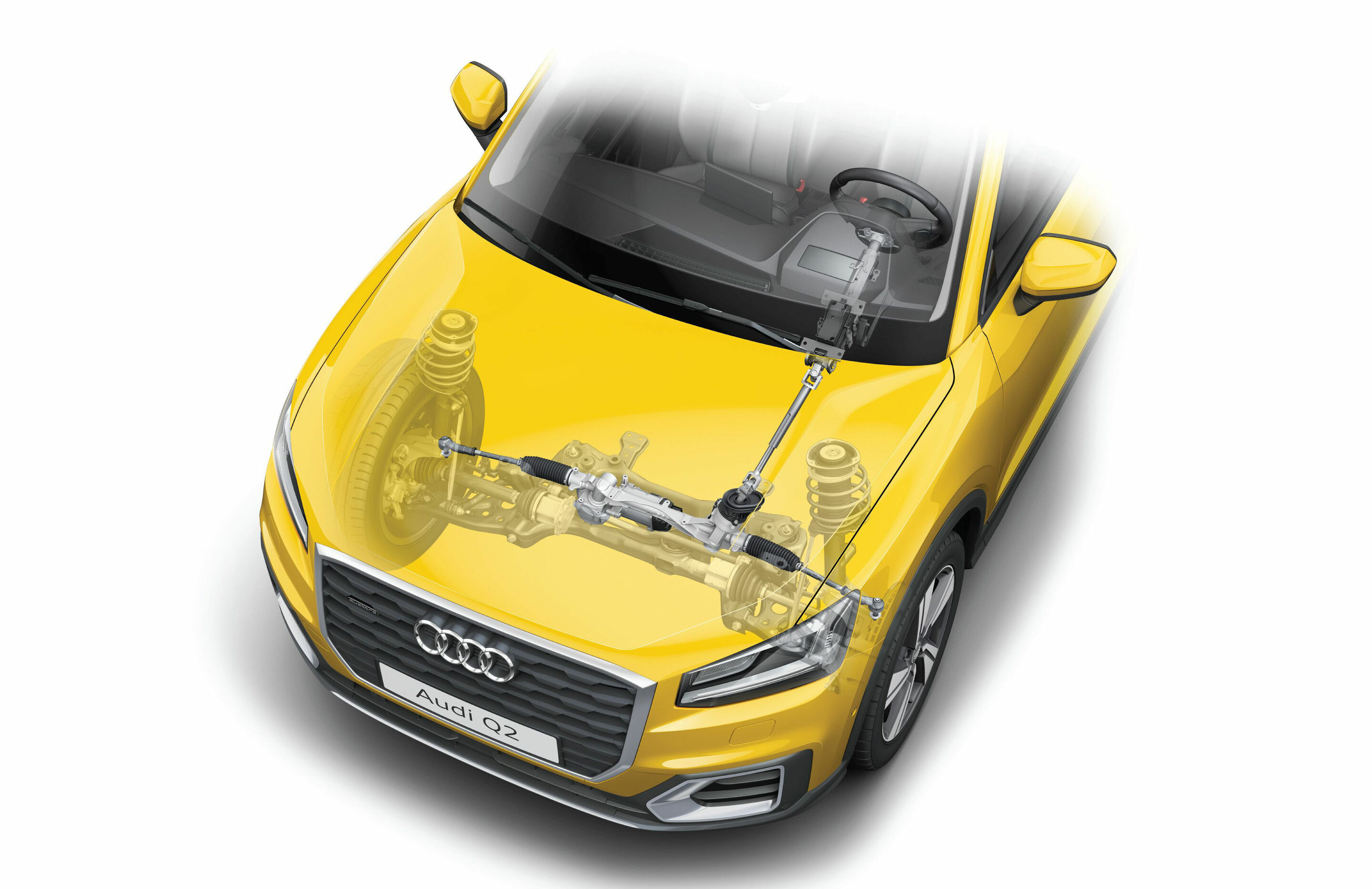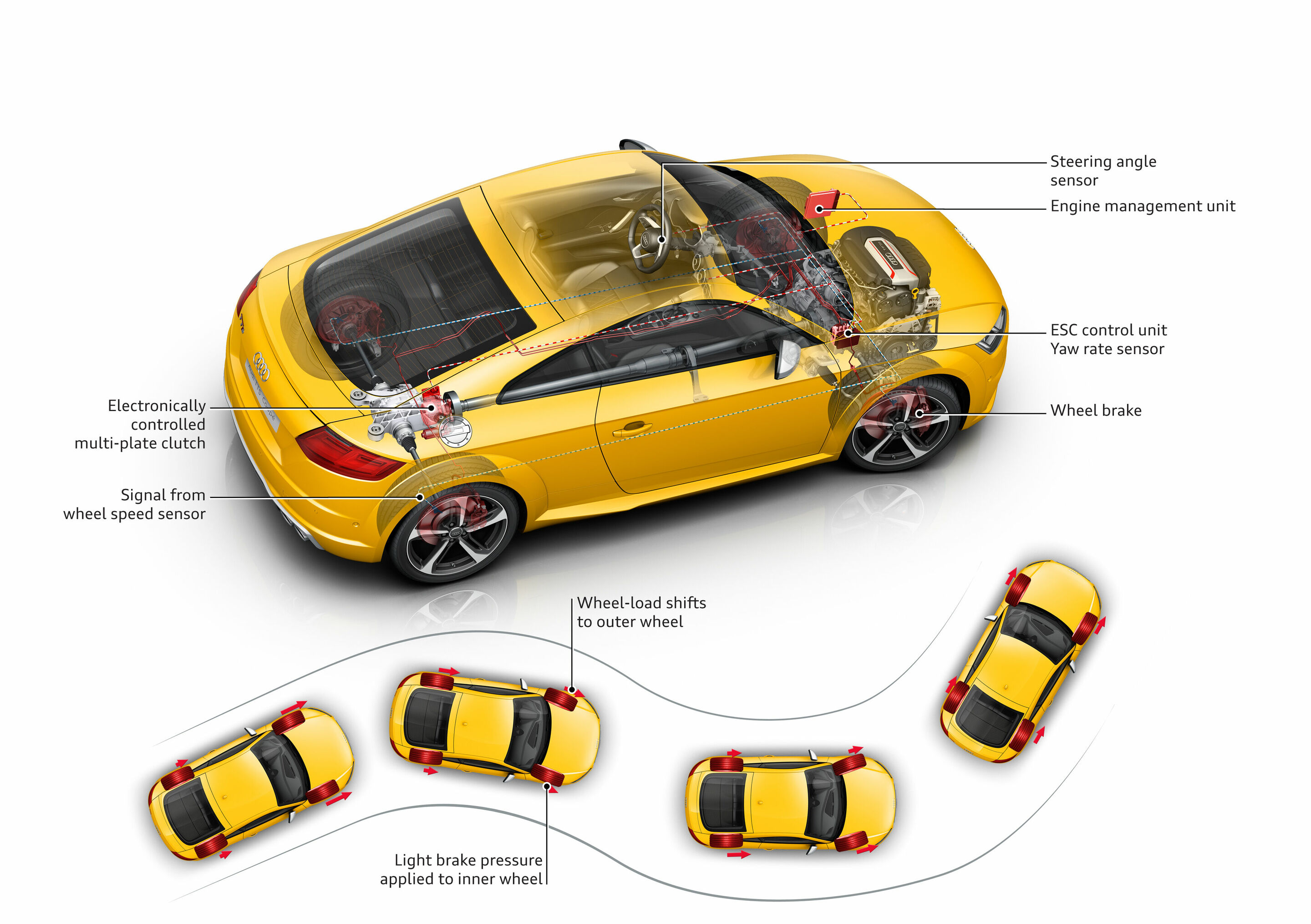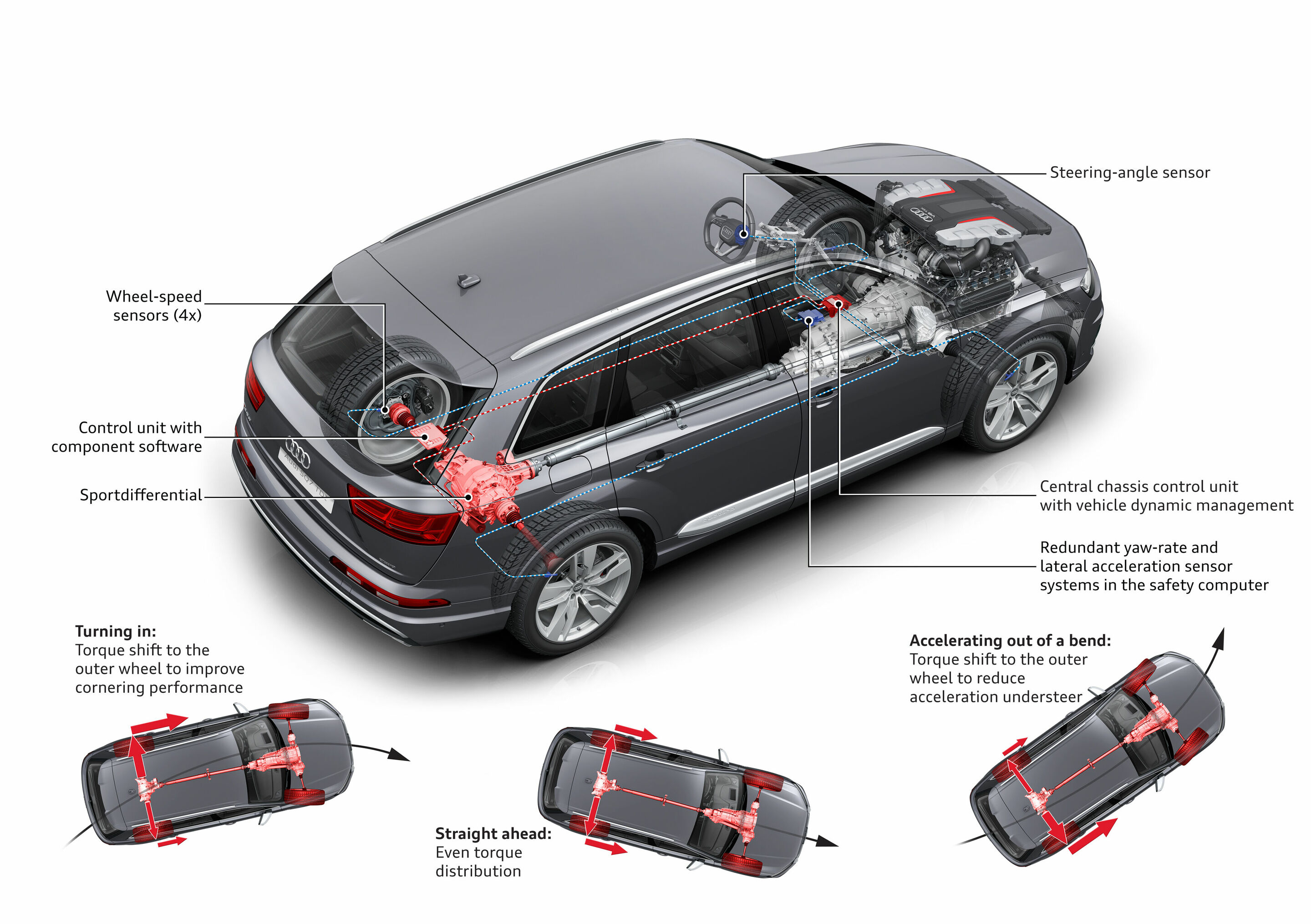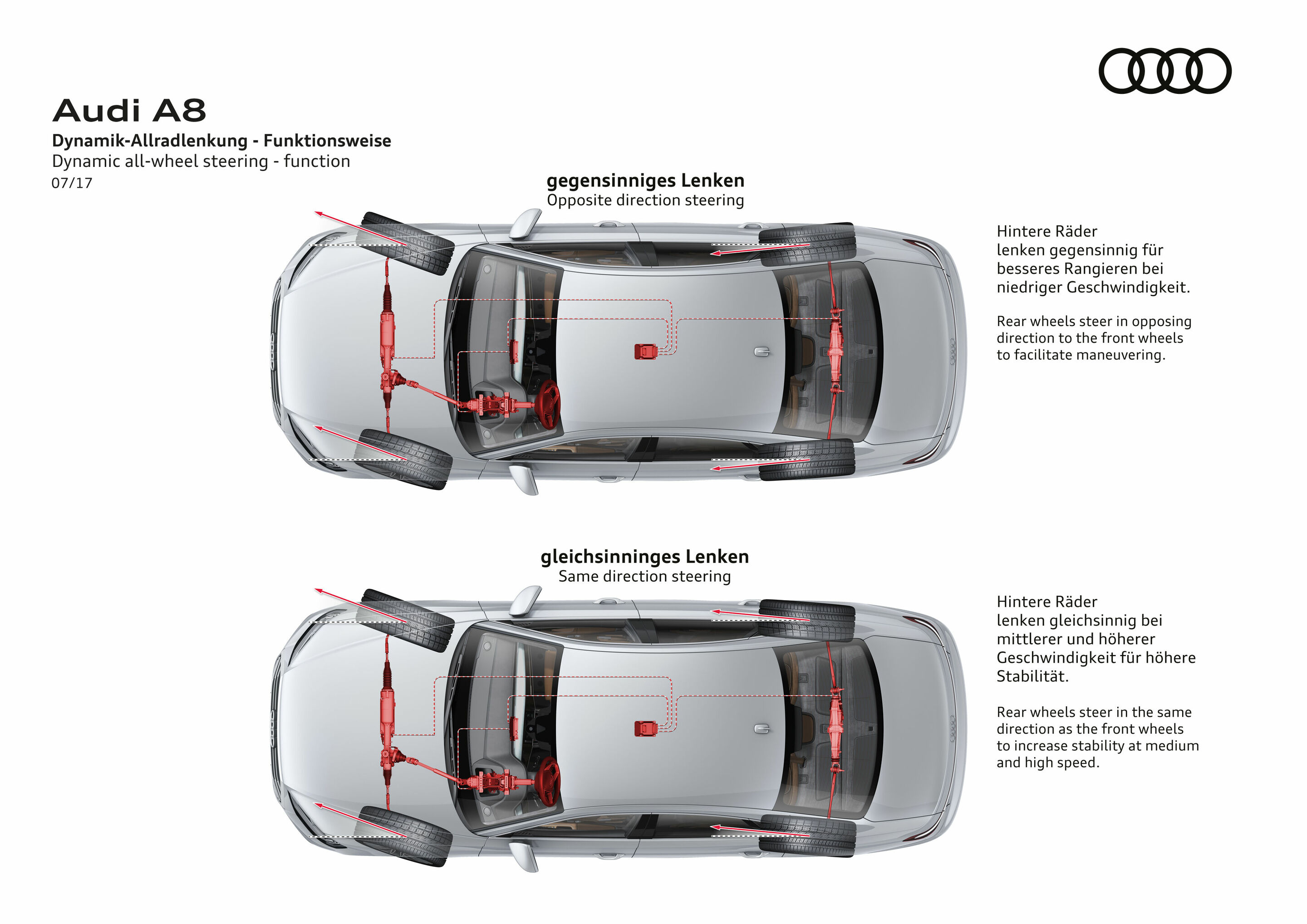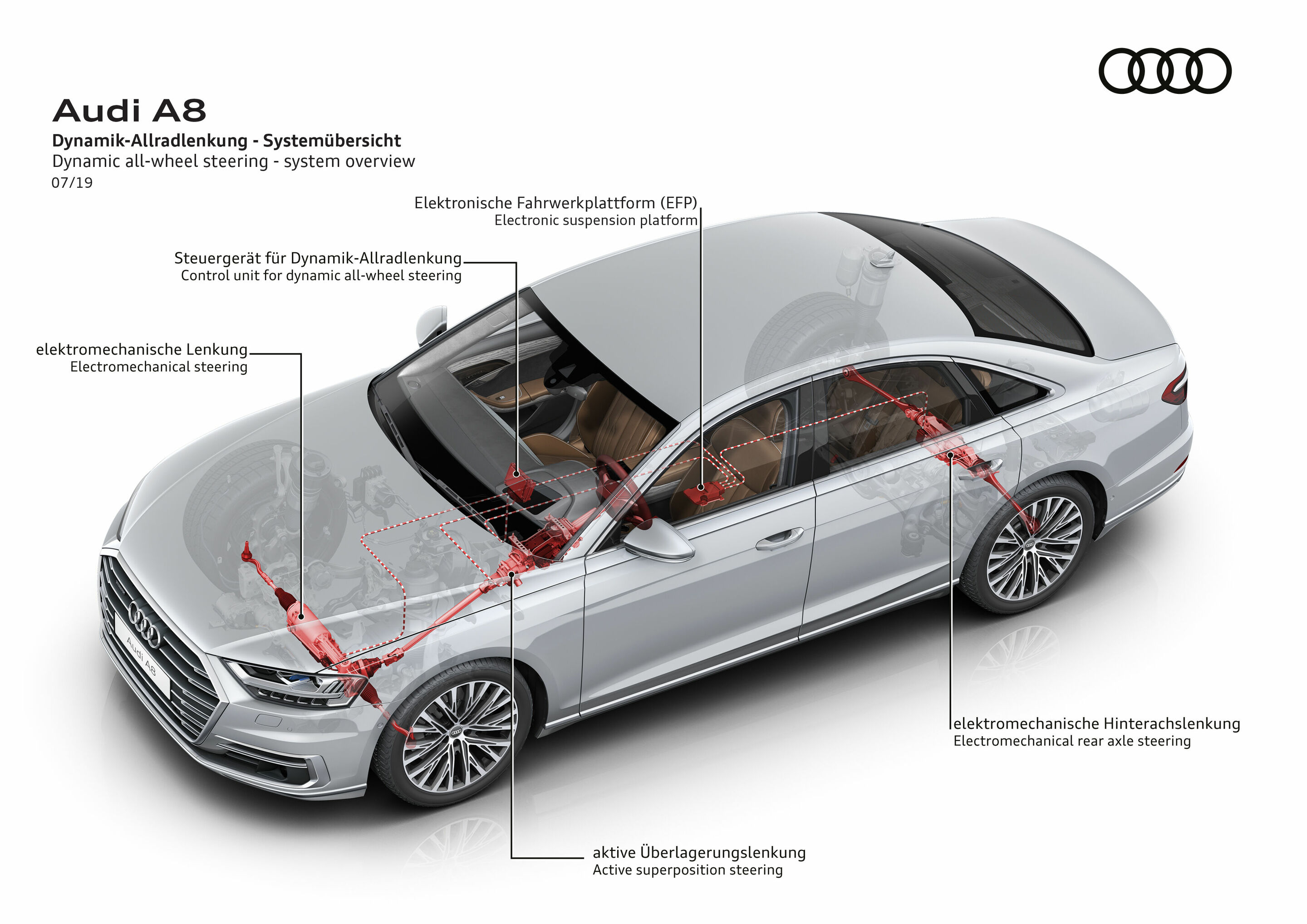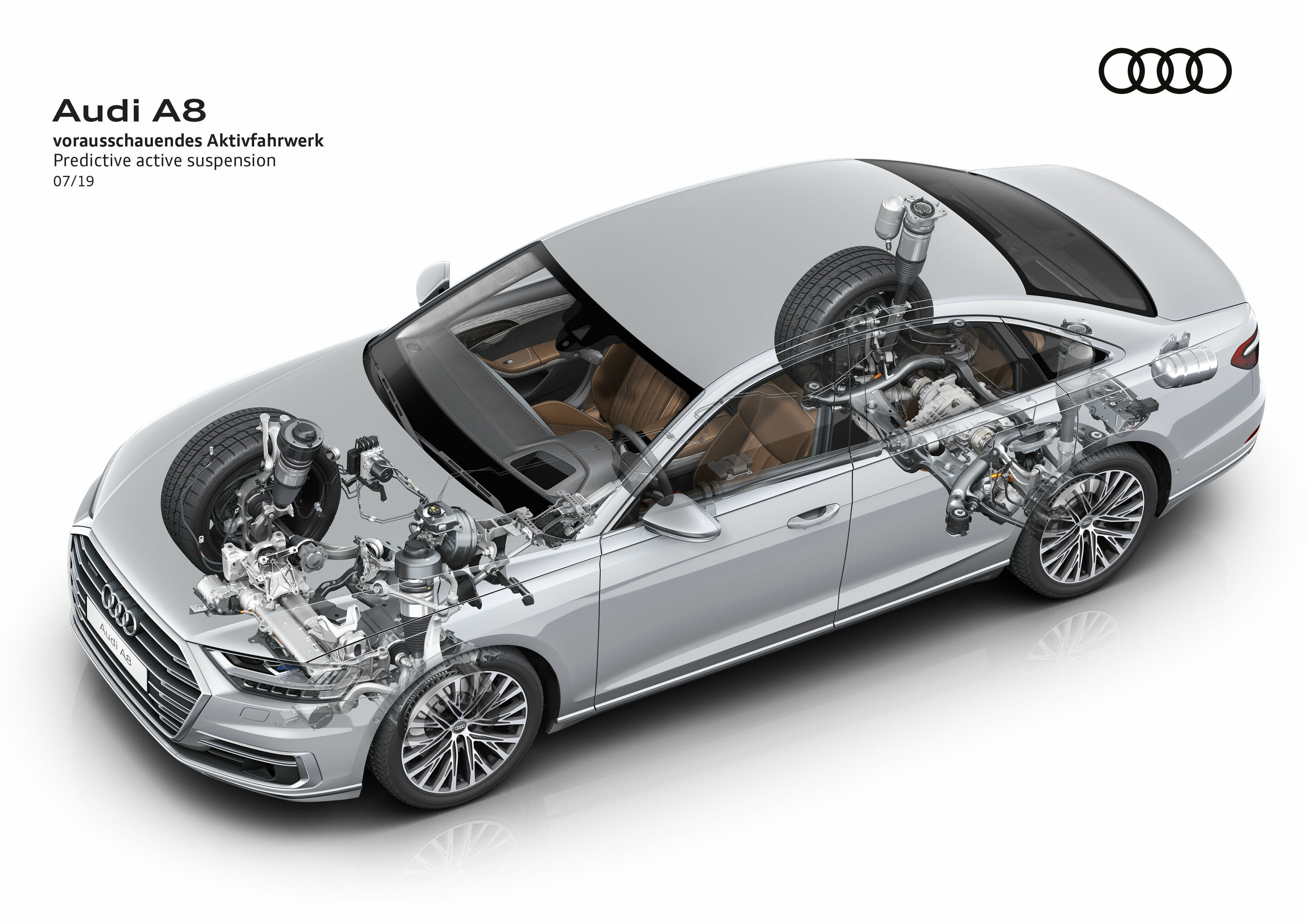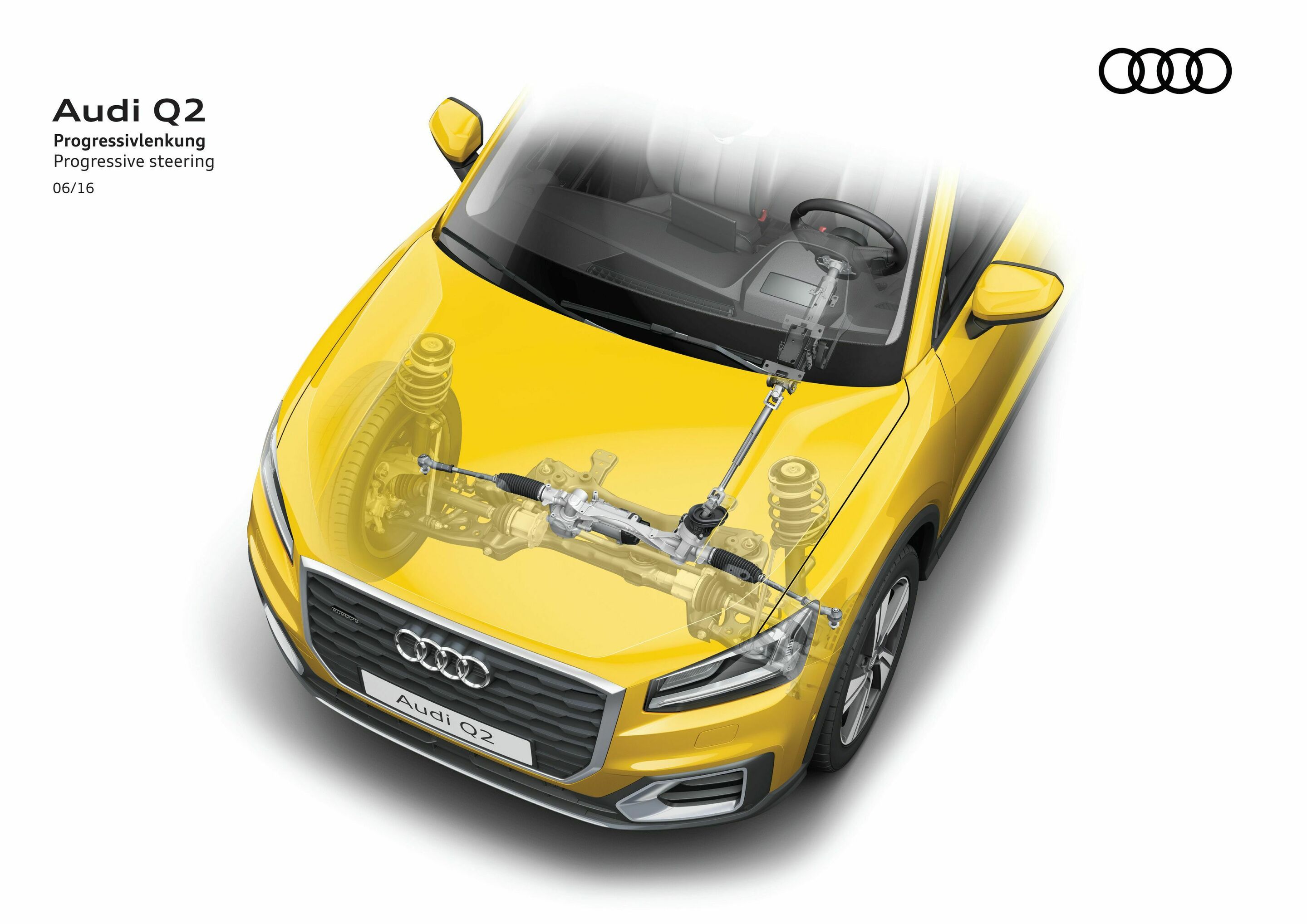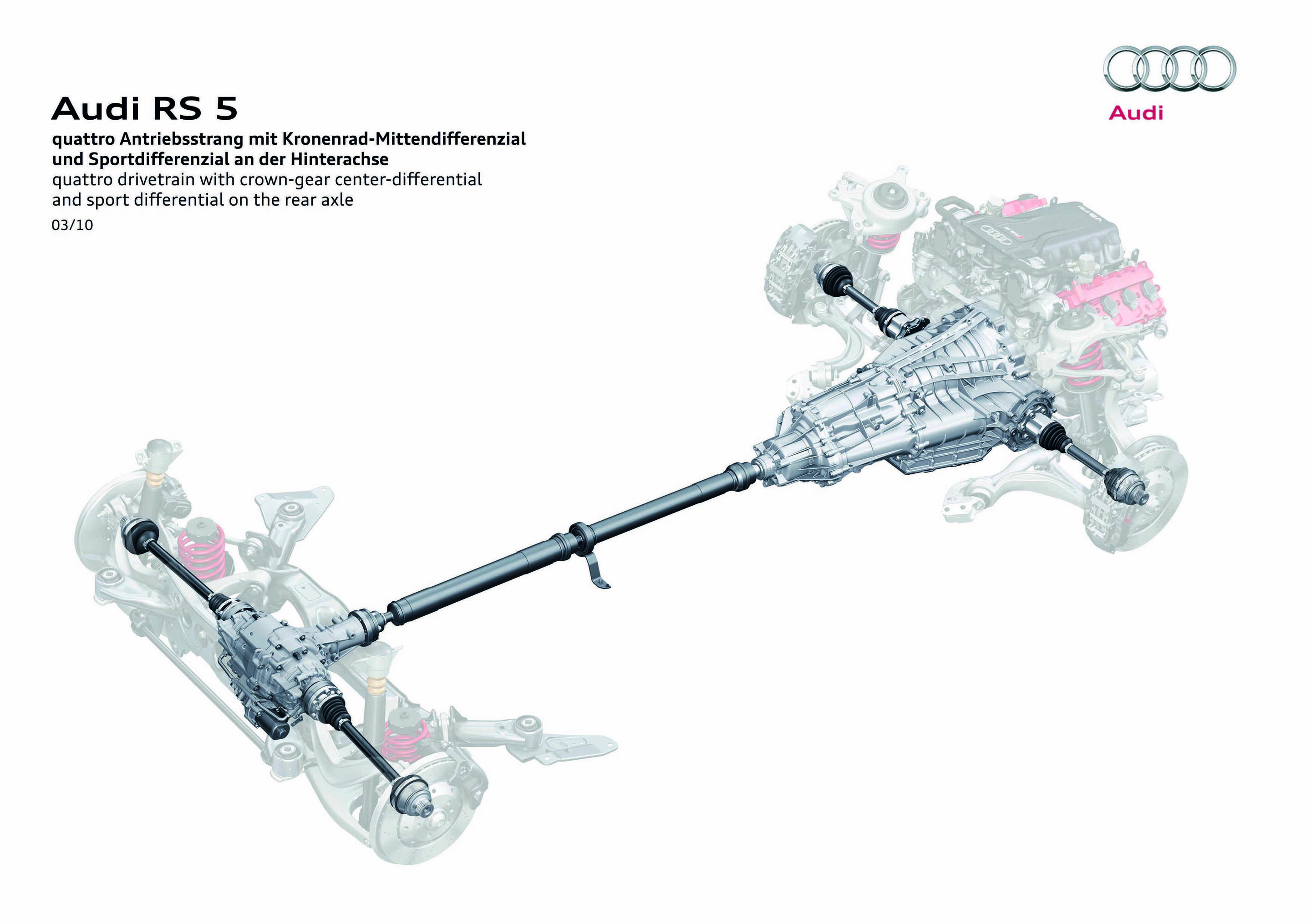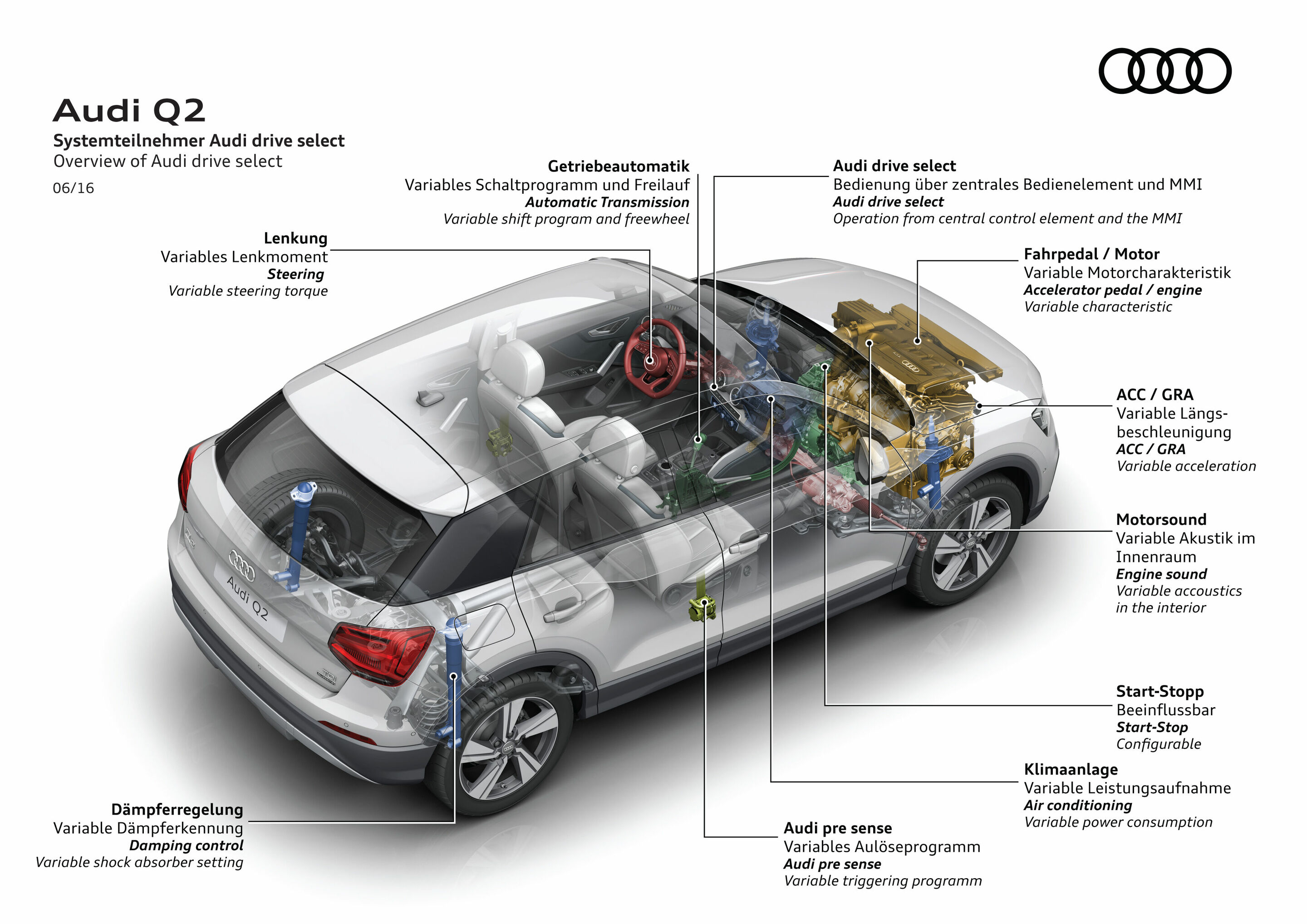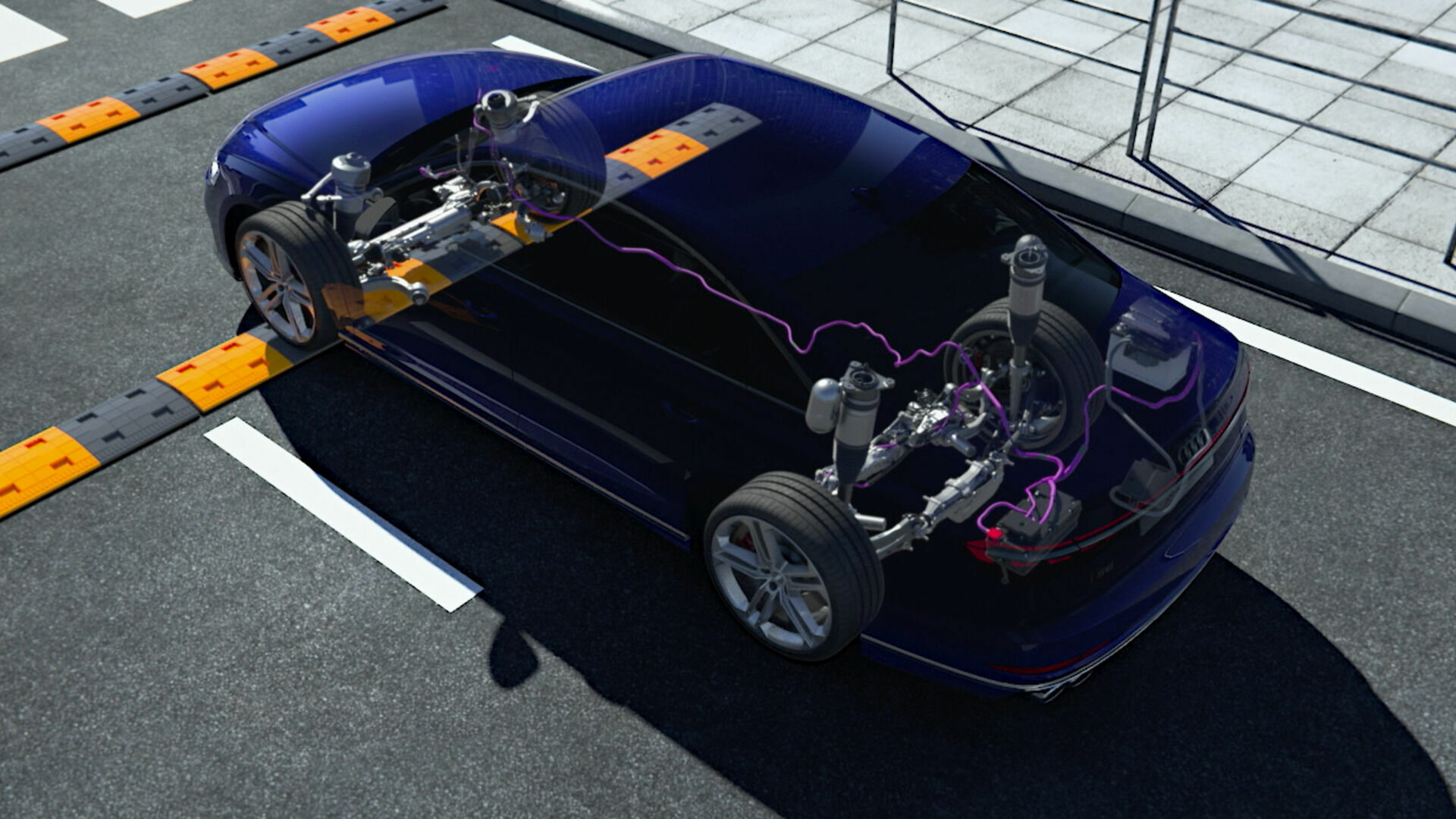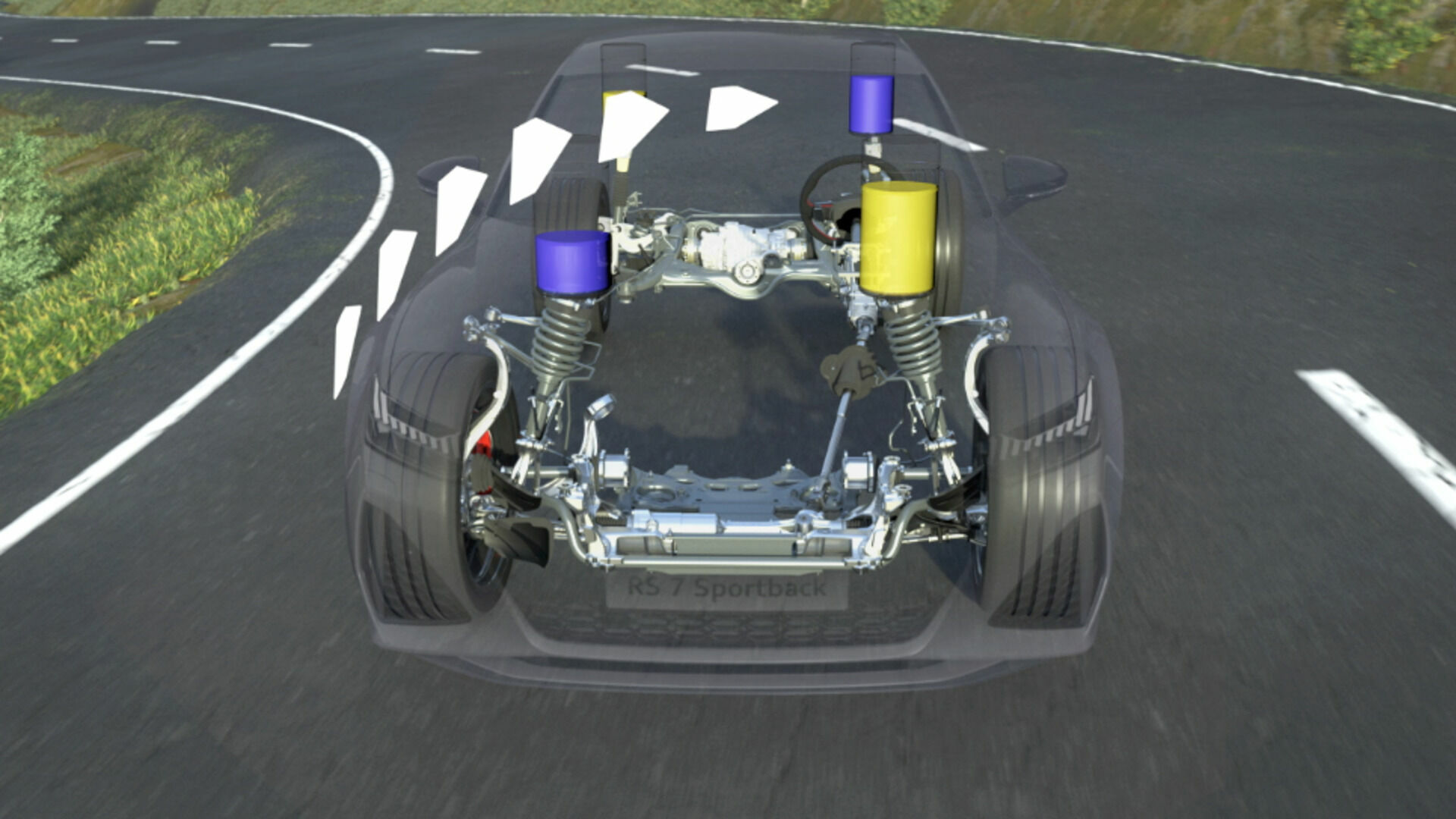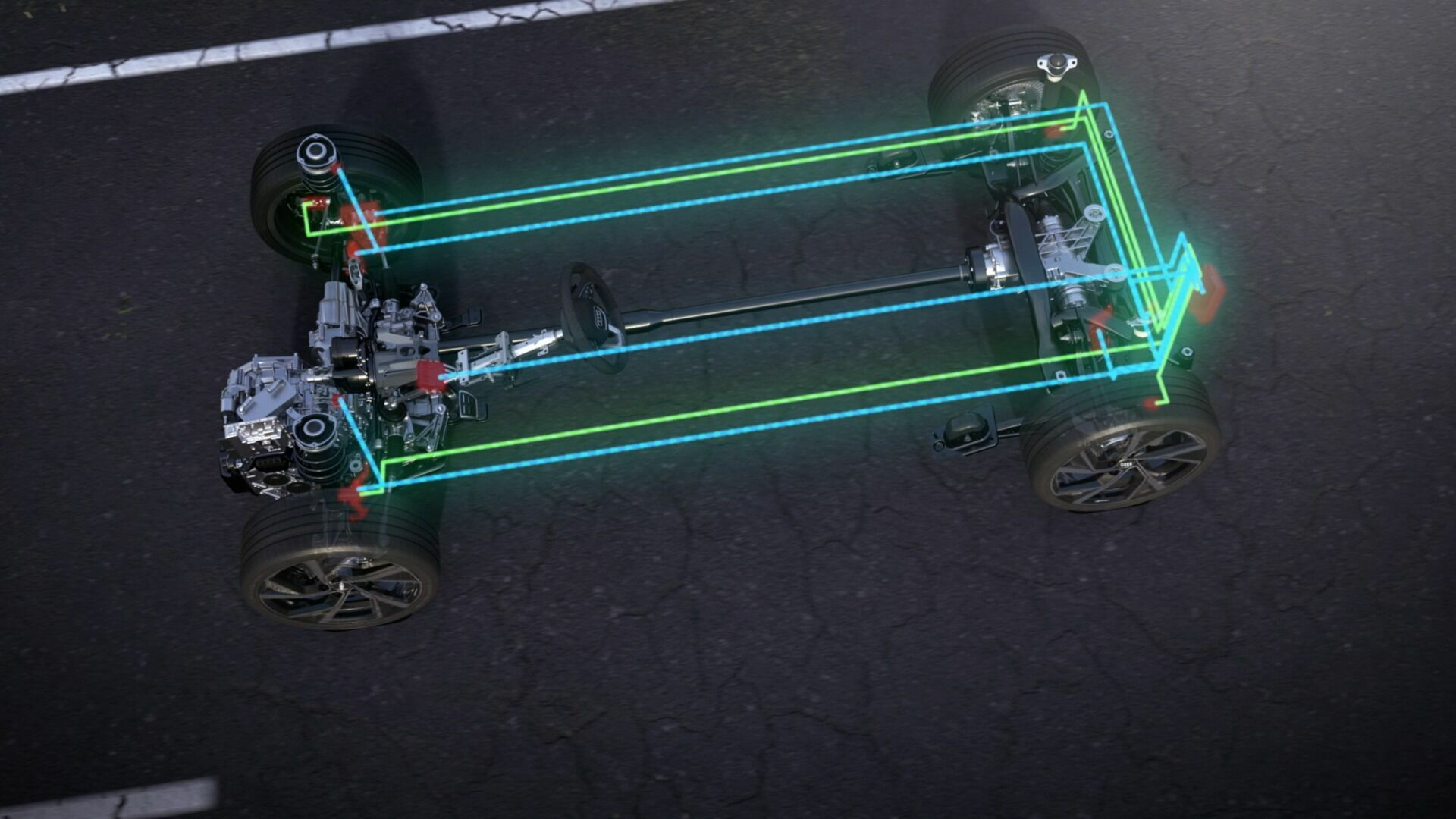Chassis
Back to overview
A high level of comfort and exciting dynamics – Audi combines these traits in its models using intelligent and extremely complex chassis technologies. In many cases, drivers can individually control the tuning of their cars.
Adaptive dampers / suspension with adaptive damper control
In the suspension with damper control, sensors measure the movements of the vehicle body. The damping characteristic is then adjusted accordingly to the road surface conditions and the driving situation. This results in enhanced driving dynamics with even more comfort. The driver can choose between several suspension settings in the Audi drive select system.
The chassis control system works with newly developed CDC dampers (CDC = continuous damping control). The pistons contain solenoid valves that offer very energy-efficient control. They allow hydraulic fluid to flow faster or slower as required. The central chassis control unit, the electronic chassis platform (ECP), processes all sensor signals within milliseconds and controls each damper individually. Together with the wide control range of the damper valves, this powerful management produces a broad spectrum of responses ranging from a soft ride to tight handling.
All-wheel steering / dynamic all-wheel steering
All-wheel steering makes the car highly manageable with maximum stability. Installed at the rear axle is a steering system with electrical spindle drive and two track rods that turns the wheels a few degrees in the same or opposite direction relative to the front wheels, depending on the driving speed. At low speeds, the rear wheels turn in the opposite direction. The car thus becomes significantly more agile, and its turning radius smaller by roughly one meter (3.3 ft) – as noticed quite clearly by the driver during maneuvering and parking. At higher speeds the rear wheels follow the movement of the front wheels. Turning in the same direction improves the steering response and further increases stability in evasive maneuvers.
The next evolutionary stage of the system is the dynamic all-wheel steering. It revisits the limits of what is physically possible, as it allows the steering angle of the front and rear wheels to be adjusted independently. It combines direct, sporty steering response with unshakable stability, resolving an age-old conflict of aims. The strain valve gearing of the dynamic steering system on the front axle varies its ratio depending on the driving situation. Through the combination of dynamic steering and rear axle steering, the overall steering ratio varies from 9.5:1 to 17.0:1 – direct at low speeds, stable at high speeds.
As with all-wheel steering, dynamic all-wheel steering is integrated into the Audi drive select dynamic handling system, where its characteristics and ratio can be adjusted in three stages. The dynamic all-wheel steering receives its commands from the electronic chassis platform (ECP). It uses steering interventions at the front and rear axles to stabilize the car at the driving limits – during understeer, oversteer and load changes – or when driving on roads that are slippery only on one side.
Predictive active suspension
The predictive active suspension is a fully active, electromechanically operated suspension system. It can increase or reduce the load on each wheel individually to adjust to the road as needed. The system therefore actively controls the position of the body in every driving situation.
For each wheel there is one electric motor supplied by the 48-volt primary electrical system. The electronic chassis platform (ECP) sends control signals to the active suspension every five milliseconds. One power electronics unit per axle processes them for the electric motors. A belt drive and compact strain wave gearing step up the torque of the electric motor to 1,100 Nm (811.3 lb-ft) and transfer it to a steel rotary tube. The tube houses and is rigidly joined to a pre-tensioned titanium roll bar. This bar is more than 40 centimeters (15.7 in) long, roughly 22 millimeters (0.9 in) thick and, despite its high strength, can be twisted more than 20 degrees. The force is transferred from the end of the roll bar to the suspension via a lever and a coupling rod. This force is exerted at the front axle on the pneumatic strut of the adaptive air suspension and at the rear axle, on the transverse link.
The range of ride characteristics takes on a whole new dimension thanks to the flexibility of the active suspension. If the driver chooses “dynamic” mode in the Audi drive select system, the car becomes a sports car. It turns firmly into corners and body roll angles are reduced by half compared with a conventional suspension. The body hardly dives at all during braking. In “comfort” mode, however, it glides smoothly over any and all road surface irregularities. The active suspension settles the superstructure by continuously adding energy to or removing energy from the body depending on the respective driving situation. This significantly reduces the system’s energy consumption. Its average power consumption is between 10 and 200 watts.
In combination with the Audi pre sense 360˚ safety system, the active suspension also enhances passive safety. The system uses the sensors networked in the central driver assistance controller (zFAS) to detect risks of a collision around the car. In the event of an imminent side impact at more than 25 km/h (15.5 mph), the suspension actuators raise the body on the exposed side by up to 80 millimeters (3.1 in) within half a second. As a result, the collision is directed to the even stronger areas of the vehicle, such as side sills and floor structure. The load on occupants is reduced by up to 50 percent compared with a side impact where the body is not raised.
Audi drive select
The Audi drive select dynamic handling system allows drivers to experience different setups in their Audi. Choosing one of the modes auto, comfort, dynamic or efficiency changes the characteristic of important drive and suspension components from a comfort bias to distinctly dynamic or particularly fuel-efficient. In individual mode, drivers can configure the setup according to their personal preferences. Q and allroad models also includes allroad and offroad modes, which in combination with the adaptive air suspension trims the car for driving off the beaten track.
In all models, Audi drive select influences the engine characteristic and steering. Optional equipment features may extend the number of tuning parameters (depending on the model).
They are
- automatic transmission
- quattro drive
- sport differential
- adaptive air suspension with electronic damper control
- suspension with damper control
- dynamic steering, all-wheel steering and dynamic all-wheel steering
- electromechanical active roll stabilization
- active suspension
- Matrix LED headlights and HD Matrix LED headlights
- ambient lighting
- automatic air conditioning
- adaptive cruise control (ACC) or adaptive cruise assist (ACA).
In some particularly sporty models, the system also controls the exhaust flaps. The system is controlled using the MMI system and, depending on the model concerned, buttons on the center console.
Audi magnetic ride
Audi magnetic ride continuously adjusts the function of the shock absorbers to the road conditions and driving style of the driver. The synthetic hydrocarbon oil circulating in the pistons of the shock absorbers contains tiny magnetic particles ranging in size from 3 to 10 thousandths of a millimeter – ten times thinner than a human hair. When voltage is applied to a coil integrated into the dampers, it creates a magnetic field that changes the orientation of the particles. Set transversely to the oil flow direction, they inhibit its flow through the piston channels. The entire process takes just a few milliseconds.
Using precise sensor data, a control unit continuously calculates the optimal levels for each individual wheel and adaptively adjusts the operation of the dampers. The wheels are precisely braced during cornering and body roll is largely suppressed. During braking, Audi magnetic ride counteracts the tendency of the body to dip. The damper control performs the described functions independently from the driving mode selected in Audi drive select, but the driver can vary the basic tuning of the dampers in the three levels: comfort, auto and dynamic. In normal mode (auto) – with low oil viscosity and high flow – the car offers up a balanced ride. In sport mode (dynamic) – when flow is restricted – it is uncompromisingly firm on the road. In both modes, the focus is on transverse and longitudinal dynamics. When the driver selects “comfort,” the wheels are damped with a focus on reducing vertical body movement to a minimum. This provides a comfortable ride despite poor road conditions.
Speed-controlled traction control
The Audi e-tron features innovative traction control, which substantially increases traction and handling stability. The Electronic Stabilization Control (ESC) and the power electronics have been networked in a new way based on the engine speed. By shifting function modules to the power electronics the wheel slip is controlled at millisecond intervals – 50 times faster than before. This enables the slip to be adjusted to the driving situation much more precisely and becomes noticeable to the driver particularly in combination with the four-stage function modes of the ESC – ON, OFF, Sport and Offroad. In conjunction with the electronic differential lock of the ESC and the all-wheel controller, the new traction control provides optimum power transfer between tires and road surface. The result is the high level of traction and stability under all conditions that is the hallmark of Audi.
Dynamic Ride Control
Sport suspension plus with Dynamic Ride Control (DRC) is a particularly dynamic damping technology for selected Audi RS models. The single-tube dampers have a variable characteristic that the driver can adjust in three stages. The diagonally opposed pairs of shock absorbers are linked by hydraulic lines and a central valve. When cornering at speed, the valves regulate the oil flow in the shock absorber of the spring-deflected front wheel at the outside of the curve. They increase the support provided and reduce pitch and roll movements. This lets the vehicle hug the road more tightly and improves handling.
Dynamic steering
Dynamic steering varies the steering ratio by up to 100 percent based on the driving speed, steering angle and selected mode in the Audi drive select handling system. The central component is superimposition gearing in the steering column, which is driven by an electric motor. Known as strain wave gearing, its construction is compact, lightweight and torsionally rigid. It is free of play, precise and exhibits low friction. The gearing can transmit tremendous torques extremely rapidly and achieves a high level of efficiency.
The strain wave gearing performs its task with just three key components. An electric motor turns an elliptical internal rotor, which deforms a thin-walled sun wheel via a ball bearing, which is connected to the steering input shaft. At the vertical axes of the ellipse it meshes with a hollow wheel that has a sprocket and acts on the steering output shaft. When the internal rotor turns, the large axis of the ellipse shifts, which brings it into the tooth engagement zone. Because the sun wheel has fewer teeth than the hollow wheel, the two exhibit a relative motion to one another – they are superimposed. The large gear ratio of the fast-running electric motor makes it possible to build up this ratio quickly and precisely.
At low driving speeds – in city traffic and in maneuvering – the dynamic steering operates very directly; all it takes is two full turns of the steering wheel to travel from end stop to end stop. The power steering boost is also high, making parking maneuvers very easy. On country roads, the directness of the steering response and steering power assist are reduced progressively. At fast expressway speeds, indirect gear ratios and low power assist are used to smooth out unsteady steering movements to enable impressive straight tracking.
Dynamic steering works closely with the electronic stabilization control program, ESC to achieve sporty handling and driving safety. If necessary, it counter-steers slightly; its slight interventions, most of which are unnoticeable to the driver, reduce understeer and oversteer due to load alterations in the vast majority of situations. When braking on road surfaces with split friction coefficients, the system helps by means of stabilizing steering interventions.
Dynamic steering takes less time for its corrections than the brake system needs to build up pressure at the wheels. In many situations, it handles the primary work – brake interventions either become unnecessary or they just serve a dampening function that reduces driving speed. The advantages in terms of driving safety and sportiness are especially noticeable at high speeds and on slippery surfaces such as snow.
Electrohydraulically integrated brake control system
The Audi e-tron is the first electric series production model uses an electrohydraulically integrated brake control system. The wheel brakes are actuated hydraulically, the reinforcement is actuated electrically, and the activation is actuated electronically. The control unit detects with how much force the driver is depressing the brake pedal and calculates how much braking torque is needed within milliseconds. If the recuperation torque is not sufficient, hydraulic pressure for the conventional friction brake is generated in addition. Put into motion by an electric spindle drive, the displacement piston pushes the brake fluid into the brake lines. The transition from the engine brake to the pure friction brake is smooth, and the driver does not notice it. A second piston generates the familiar pedal feeling for the driver’s foot by means of a pressure-resistant element. Thanks to this brake pedal simulator, the driver is not affected by what is happening in the hydraulics. In the case of ABS braking, pressure buildup and reduction are not noticeable in the form of irritating hard pulsations.
The electrohydraulic brake system is activated when the driver depresses the left-hand pedal so hard that the deceleration exceeds 0.3 g; otherwise, the Audi e-tron decelerates through recuperation via the two electric motors. The brake control system build up brake pressure for the wheel brakes with great precision and roughly twice as fast as a conventional system. When automated emergency braking is performed, there are only 150 milliseconds between the initiation of the brake application and the presence of maximum brake pressure between the pads and disks. This is barely more than a blink of the eye and creates impressively short braking distances. Even at a very slow speed, such as during maneuvering, the car decelerates via the wheel brakes because this is more efficient than electric braking in this case. Otherwise, the electric motor would have to use valuable battery current to decelerate actively at low rotational speeds.
The “brake-by-wire” technology of the electrohydraulically integrated brake control system enables a larger air gap, i.e. a greater distance between the brake pad and brake disk, to be set. This minimizes possible friction and heat generation and contributes actively to the vehicle’s long range.
Electromechanical active roll stabilization
Electromechanical active roll stabilization ensures an extensive spread between smoothness of build-up and sporty handling. On the front and rear axle, between the two halves of each stabilizer, there is a compact electric motor with a three-stage planetary gear set. When driving straight ahead, the suspension control ensures that both halves of the stabilizer act largely independently of one another. This reduces the sprung mass vibrations on uneven roads, thus increasing ride comfort. At sporty paces, however, the focus is on optimum roll compensation. The halves of the stabilizer act as a unit and are twisted in opposite directions by the transmission of the electric motor; the roll angle is reduced significantly when cornering, and the handling of the vehicle becomes even more firm and dynamic.
Electromechanical active roll stabilization draws its power from a potent 48-volt electrical subsystem and acts as a recuperative system: If the wheels on one axle are deflected to greatly differing extents on bumps in the road, they excite the stabilizer – the electromechanical active roll stabilization motor now converts each impulse into electrical energy. This energy is stored in the electrical subsystem’s lithium-ion battery, ensuring that the overall energy balance of the electromechanical active roll stabilization is significantly more favorable than that of a hydraulic system. Furthermore, active roll stabilization is maintenance-free because it uses no oil.
Electronic chassis platform
The electronic chassis platform (ECP) is the central control unit for the chassis. It records the speed, the height values, the vertical, roll and pitch movements of the car, the coefficient of friction of the roadway, the current driving state – such as under or oversteer –, and the data of the involved suspension systems. From these, it quickly calculates and precisely coordinates the optimal function of these components. Thanks to the central control, the customer experiences ride characteristics more distinctly in the form of precise cornering, improved dynamics and a high level of ride comfort.
Adaptive air suspension
The adaptive air suspension – an air suspension system with controlled damping – offers a wide range between smooth cruising and sporty handling. Depending on the speed and the driver’s preferences, it individually adjusts the ride height according to the road conditions. The air suspension also offers level control as a function of load.
The system is designed differently for the different individual product lines. In the front suspension struts, air springs enclose the shock absorbers. In most models, these two components are implemented separately in the rear suspension. In the Audi A8 (2017), however, pneumatic struts are also mounted on the rear suspension. The mounting orientation of the compressor and the number of pressure reservoirs to be filled also differ, depending on the model.
The central chassis control unit, the electronic chassis platform (ECP), individually controls the function of the shock absorbers on each wheel at cycles in the order of milliseconds – according to the road surface condition, driving style and the mode the driver sets in the Audi drive select dynamic handling system. Solenoid damper valves vary the volumetric flow of the hydraulic fluid.
Progressive steering
The electromechanical progressive steering enhances both handling and ride comfort. Its specially toothed gear rack varies the ratio as a function of the steering angle. As steering wheel turn increases, the ratio decreases and steering becomes more direct. This reduces steering effort in urban traffic and when maneuvering; in tight curves the car is even more agile. Here, progressive steering provides for sporty handling. It also adjusts the power assistance level as a function of driving speed. It is increased at low speeds for easier maneuverability. The steering characteristic can be varied between a number of modes in the Audi drive select dynamic handling system.
Wheel-selective torque control
Both in quattro drive and in front-wheel drive the wheel-selective torque control rounds off the handling with electronic interventions. The system is active on all types of road surfaces. During sporty driving, it minimally brakes the front wheel on the inside of the curve (for front-wheel drive) or both wheels on the inside of the curve (for quattro drive), thus increasing the drive torque to the wheels on the outside of the curve with the higher wheel load. The difference in drive forces turns the car into the bend, allowing the car to follow the steering angle precisely. The result: precise, agile and neutral handling.
In the Audi e-tron the wheel-selective torque control is not integrated into the Electronic Stabilization Control, but into the electronic chassis platform and, in turn, forms part of the all-wheel control for the first time. As a result both systems can be optimally coordinated and supplement each other mutually.
Sport differential
The sport differential provides for better driving dynamics, traction and stability. It actively distributes drive torque between the rear wheels, adding a self-locking center differential to the quattro drive.
In addition to the features of a conventional differential, the sport differential integrates an internal gear and a multi-plate clutch with electro-hydraulic actuation on the left and right. The clutches are operated by the hydraulic control unit. An electric motor drives the high-performance oil pump, which generates the required hydraulic pressure. When the clutch closes, it steplessly forces the higher speed on the superposition gear for the relevant wheel. When it is forced to turn faster, the extra torque required for this is taken – via the differential – from the wheel across from it on the inside of the curve. In this way nearly all of the torque can be directed to one wheel.
The sport differential can distribute the torque between the left and right wheels in all operating states, including in overrun. When turning into or accelerating in a curve, most of the torque is directed to the outside wheel – the vehicle is literally pushed into the curve and even the onset of understeer is eliminated. In case of oversteer, the sport differential stabilizes the vehicle by shifting torque to the wheel on the inside of the curve.
In many models the sport differential is controlled by the electronic chassis platform. The software for the sport differential constantly computes the ideal distribution of torque at the rear axle for driving dynamics. This takes into account the steering angle, yaw rate, lateral acceleration and driving speed. Drivers can influence system characteristics by networking with Audi drive select. In some models, they can have the torque distribution displayed on the center display. The graphic depiction includes both the distribution of torque between the front and rear axles and the distribution between the wheels of the rear axle.
